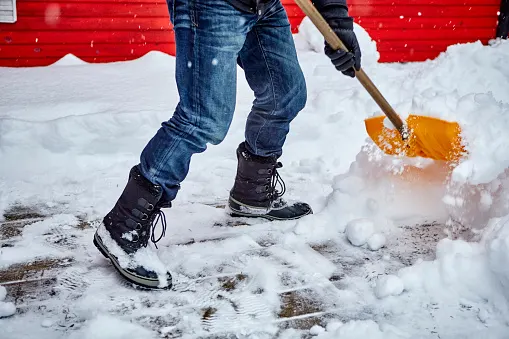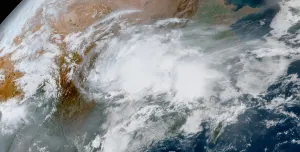
The hidden costs of poor snow clearing in Alberta
Two years ago, CBC News published an analysis of hospital data that showed Albertans are seriously injured from falling on ice at triple the rate of people in Ontario.
Since then, it's only gotten worse.
During the last winter on record, Albertans were hospitalized at nearly quadruple the rate of Ontarians. And we're not talking minor bumps and bruises here; these are major injuries that require serious medical attention and often result in long-term health complications. Sometimes, they're fatal.
Icy roads also increase the risk of collisions, which are costing drivers more and more, collectively. Auto insurance claims have been skyrocketing, as of late, and consumers are being warned of another major hike in premiums in the new year.
These are just some of the costs that come with Alberta winters. We mitigate them, to a degree, by shovelling and plowing and salting and sanding. But that comes with a cost, as well.
Calgary budgeted $40 million for snow and ice control this year and Edmonton set aside $65 million. These are significant public investments, but other winter cities in Canada provide a higher level of service — clearing sidewalks, for example, rather than requiring property owners to shovel them. Or actually removing snow from the roads, rather than just plowing and grading, as is the practice in Calgary.
The benefit of all this work is more difficult to quantify. Putting a dollar figure on the avoidance of those other costs — the injuries, the insurance premiums, the lost productivity — is a lot harder. But not impossible.
So let's take a look at some of the ballpark figures, and consider whether we're pinching pennies now at the expense of pounds in the long run.
HEALTH COSTS
In terms of injuries, the last winter on record was a bad one in Alberta.
A total of 1,860 people were hospitalized after falling on ice in 2017-18, according to the latest data from the Canadian Institute for Health Information.
That's 44 hospitalizations per 100,000 Albertans, putting us just behind Saskatchewan's rate of 47 but well ahead of Ontario's, which was less than 12.
The direct cost of all those hospital stays can't be precisely calculated, but we can get a rough estimate. The cost of a standard hospital stay in this province is $7,983 (the highest in Canada). Multiply that by the number of hospitalizations and you get a ballpark figure of $15 million for the year — in hospital stays alone.
More minor injuries that don't require hospitalization but still involve a visit to a walk-in clinic or emergency department also come with a cost to the system, one that's harder to estimate. For the more serious injuries, there's also rehabilitation, physiotherapy and long-term care to consider.
These costs are fuzzy but nonetheless real.
It's a similar story when it comes to the havoc wreaked by snow and ice on Alberta's roads.
VIDEO: HOW TO SHOVEL SNOW THE RIGHT WAY
INSURANCE PREMIUMS
It's relatively easy for police investigating a car crash to point to poor roads as a factor in the collision. It's much harder to show the opposite — that good roads prevented a collision.
So we can't say precisely how many fewer crashes we'd have if our roads were better cleared of snow and ice. But, again, we can estimate.
Auto insurance claims in Alberta totalled $3.74 billion in 2017. If improved snow clearing reduced those claims by just one per cent, we'd be looking at a savings of $37.4 million. A reduction of five per cent would save nearly $187 million.
And collisions are only getting more expensive as time goes on and cars get more complicated to repair.
"There is no such thing as a small fender bender anymore," said George Hodgson, CEO of the Insurance Brokers Association of Alberta.
"In the newer vehicles, the bumpers are full of sensors, and what used to be $1,500 or so to replace a bumper is now getting into the many of thousands of dollars."
Those costs, increasingly, are being passed onto consumers.
Auto insurance claims in Alberta more than doubled between 2007 and 2017, while premiums grew at a slower rate. But lately, they're starting to catch up.
Many Albertans have already seen their premiums suddenly spike, and Sharp Insurance founder Sherif Gemayel expects the average driver will see a 15-per-cent increase in the new year.
"There's going to be a little sticker shock," he told the Calgary Eyeopener.
There's also a broader price for society, as a whole.

The sidewalks on this Calgary street were clear this week, shovelled by area residents, but the crosswalks at the intersections were covered in a thick layer of ice. (Robson Fletcher/CBC)
PRODUCTIVITY LOSS
When someone slips and falls, it doesn't just cost the health system. Their employer also has to deal with their absence from work. That can eat into the company's bottom line, which can translate into smaller dividends for shareholders and less corporate income tax for governments.
These types of losses even accrue from car crashes when no one is injured, says Moshe Lander, an economics professor at Montreal's Concordia University, who also lives and teaches in Alberta in the summers.
It might seem negligible, but if you've been in even a minor crash, you know how much time it takes to sort out the police reports, insurance claims and repair work.
"All of that stuff adds up in the form of lost productivity," said Lander.
Putting a dollar figure on all this, he said, is a "wonderfully impossible task." But it's worth considering, in broad terms, because money spent on snow clearing today might save us even more, down the road.
"Maybe an ounce of prevention," he said, "is worth a pound of cure."
Thumbnail image courtesy: Getty. This article was written for the CBC by Robson Fletcher.









